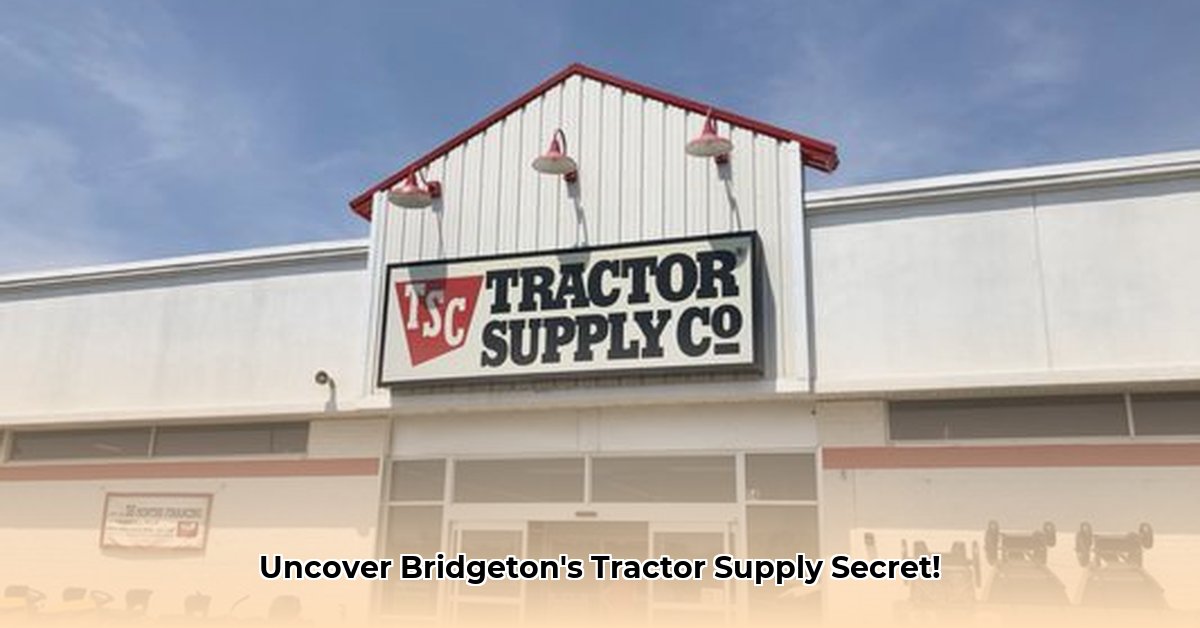
Finding the right location for a retail store is a complex undertaking, particularly for a company like Tractor Supply, which caters to a diverse customer base spanning rural and suburban areas. This analysis examines the Bridgeton, Missouri, Tractor Supply store, focusing on location optimization, customer demographics, and sales performance to illustrate key aspects of Tractor Supply's overall strategy. While we lack comprehensive data for a full evaluation, the available information provides valuable insights. For a similar analysis of a New Jersey location, see the Lodi store analysis.
Bridgeton Tractor Supply: Location and Operating Hours
The Bridgeton Tractor Supply store enjoys a convenient location within a busy shopping center, ensuring high visibility and accessibility for customers. This strategic placement reflects Tractor Supply's broader emphasis on high-traffic areas to maximize customer reach. The store maintains extended hours, operating from 8 AM to 9 PM, seven days a week, showcasing a commitment to serving the community's diverse needs. This accessibility is designed to cater to both busy farmers and city dwellers requiring convenient access to supplies.
Tractor Supply's New Jersey Presence: A Broader View
Tractor Supply maintains a significant presence across New Jersey, strategically positioning stores across rural and suburban areas. This distribution strategy aims to cover a wide range of customer bases. However, the absence of specific sales figures and detailed customer data for the Bridgeton location, and New Jersey as a whole, limits our ability to perform a comprehensive performance analysis. Further data collection is crucial for a more thorough understanding of Tractor Supply's overall New Jersey market success.
Data Limitations and Future Research Directions
This analysis is currently limited by the absence of crucial data points. The lack of sales data, detailed customer demographics and competitor analysis hinders a complete assessment of the Bridgeton store’s performance and broader market position. To gain a comprehensive understanding, future research should focus on:
- Comprehensive Sales Data: Obtaining detailed sales figures for the Bridgeton store, allowing for an accurate assessment of revenue generation and profitability.
- Customer Demographic Analysis: Gathering data on customer profiles to understand customer preferences, needs, and purchasing behaviors. This might involve surveys or point-of-sale data analysis.
- Competitive Analysis: Evaluating the performance of competing retailers in the Bridgeton area to determine market share and competitive advantages.
Actionable Insights and Stakeholder Implications
Despite data limitations, several key takeaways emerge, highlighting potential areas for improvement and future strategic planning:
- Location Optimization: The Bridgeton store's placement within a high-traffic shopping center showcases the importance of strategic location selection. Further analysis with sales data will allow for validation of this approach.
- Extended Operating Hours: The extended operating hours demonstrate a commitment to accommodating diverse customer schedules, underscoring the importance of customer convenience.
- Data Deficiency: The absence of comprehensive sales and demographic data critically limits a thorough evaluation of the Bridgeton store’s performance and strategic success.
Addressing these data gaps will be crucial for informing decisions for several key stakeholders:
- Tractor Supply Management: Detailed data will allow for improved resource allocation, optimized inventory management, and targeted marketing campaigns.
- Site Selection Team: Data analysis will enable refinement of the store location selection process, leading to more strategic and profitable store placements.
- Marketing and Sales Teams: A deep understanding of customer demographics will allow for the creation of more effective targeted marketing strategies.
Addressing Potential Challenges
Proactive risk management is crucial for long-term success. Even with limited data, potential challenges can be anticipated:
| Risk Category | Possible Problems | Mitigation Strategies |
|---|---|---|
| Economic Downturn | Reduced consumer spending, decreased profitability | Diversification of product offerings, cost optimization, and loyalty programs. |
| Competition | Increased market competition, reduced market share | Enhanced customer service, unique product offerings, and targeted marketing campaigns. |
| Supply Chain Issues | Delays or shortages of products, impacting sales | Diversified sourcing, improved inventory management, and strengthened supplier relationships. |
| Regulatory Changes | Increased compliance costs or operational restrictions | Proactive monitoring of regulatory changes and implementation of necessary adjustments. |
By proactively addressing these potential challenges, Tractor Supply can mitigate risks and maintain its competitive edge.
Improving Tractor Supply's Location Strategy in New Jersey: A Data-Driven Approach
Optimizing Tractor Supply's store placement in New Jersey necessitates a data-driven approach that considers the unique blend of rural and suburban areas.
Geographic Information Systems (GIS): Utilizing GIS technology allows for the overlaying of various data layers (population density, agricultural zones, competitor locations) to visualize optimal store locations.
Demographic Analysis: Beyond population size, detailed analysis of customer spending habits, age demographics, and lifestyle choices is crucial for understanding purchasing behaviors and targeting specific customer segments.
Competitive Analysis: Mapping competitor locations and assessing their market share helps identify opportunities in underserved areas and potential competitive advantages.
Key Performance Indicators (KPIs): Regularly tracking metrics such as sales per square foot, customer traffic, customer retention, and website traffic from nearby areas allows for continuous performance monitoring and adjustments to the store location strategy. This provides evidence-based insights for future decision-making.
By implementing these strategies, Tractor Supply can refine its location strategy in New Jersey, leading to improved profitability and enhanced market position.